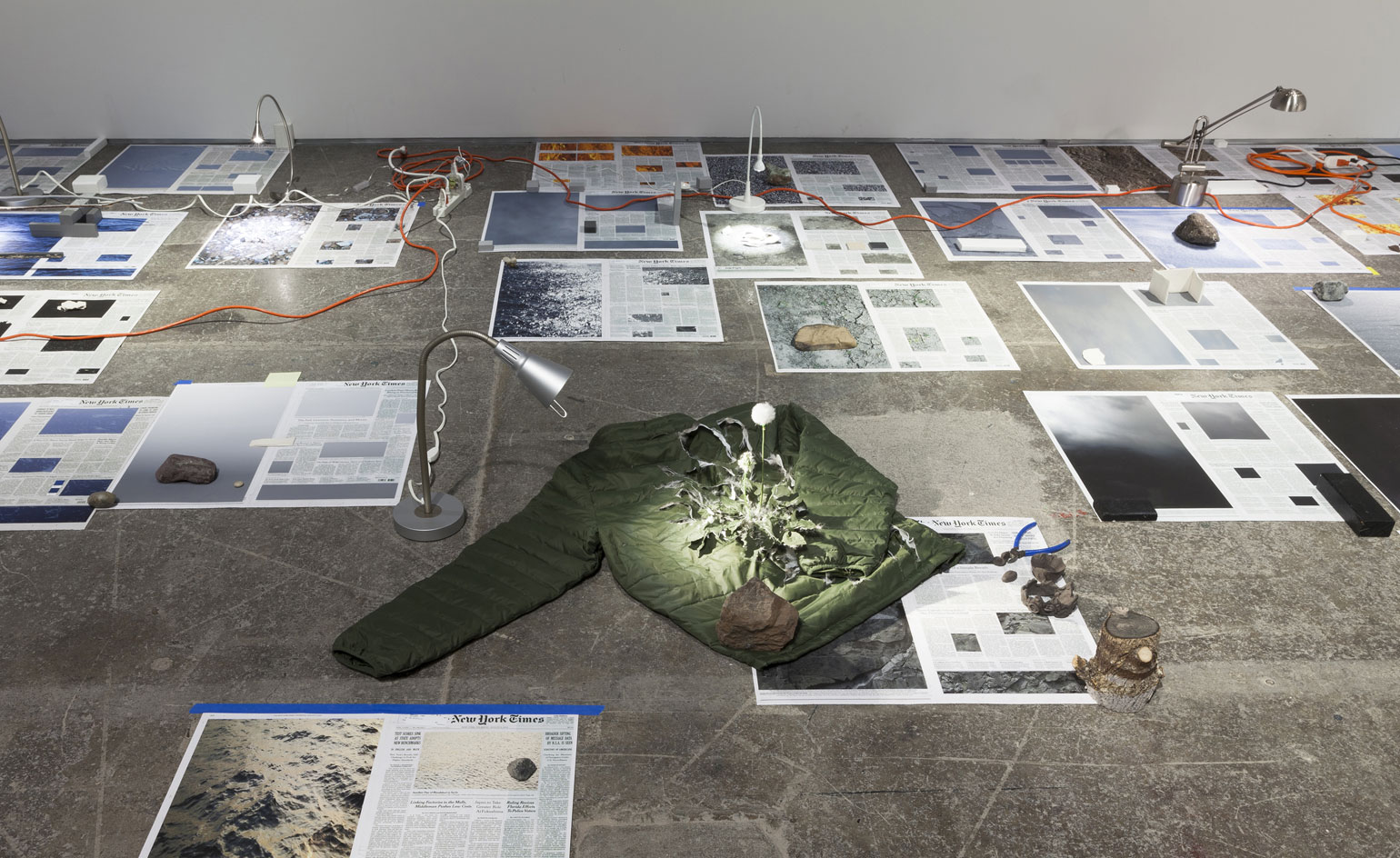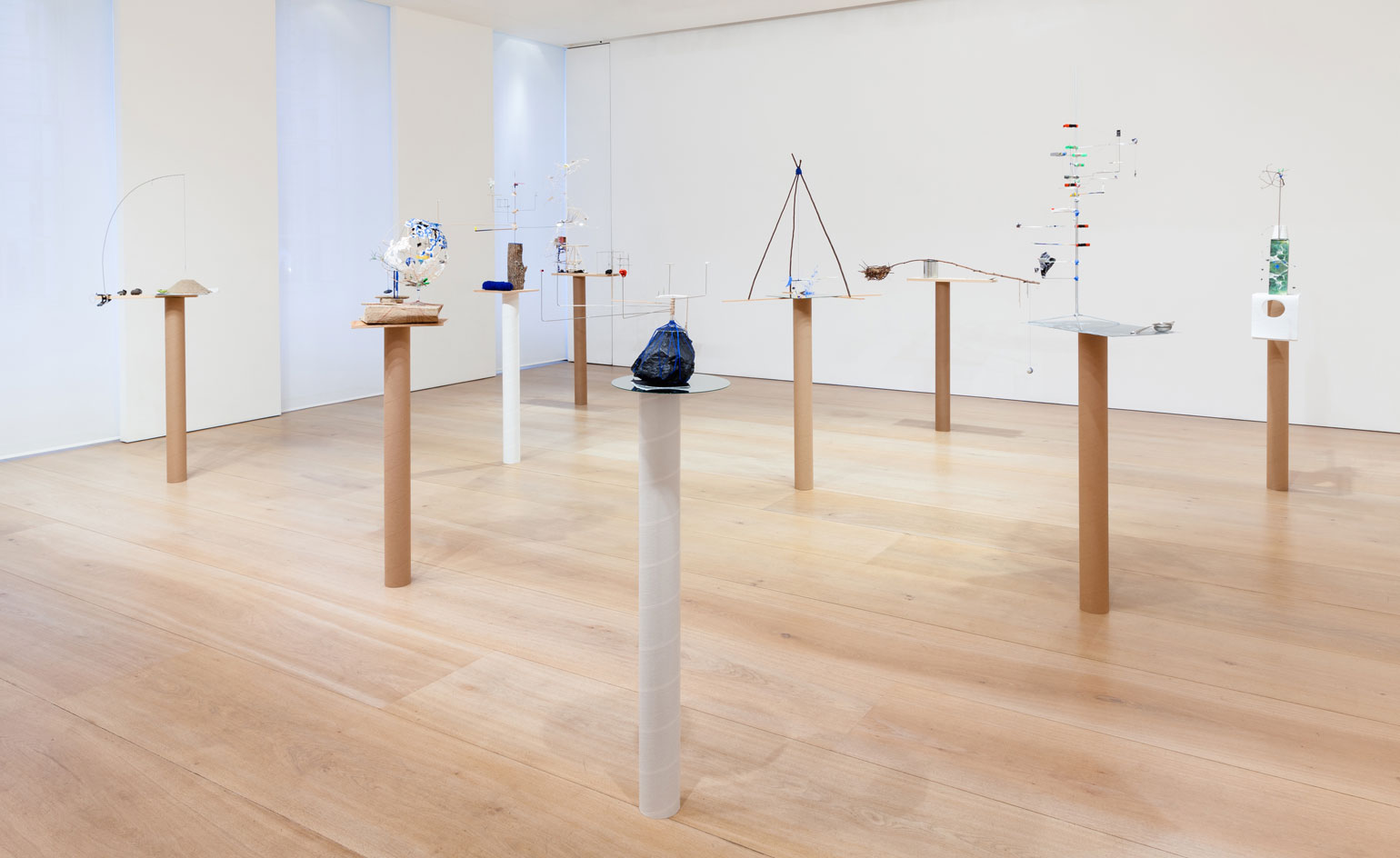Sarah Sze takes over London’s Victoria Miro galleries with a two-pronged show about time and space

Sarah Sze’s sculptures are objects in time and space, manipulations of time and space. More than that, they are models of how we think - or don’t or don’t often think enough - about time and space. In that sense they are everything a sculpture can and should hope to be.
Sze, who represented the US at the 2013 Venice Biennale, created a conceptual bird feeder for the High Line in New York, and who takes over both branches of London’s Victoria Miro gallery this month, studied architecture and painting. Which, if you do a kind of reductive arithmetic, might equal sculpture. And that maths seems to work as a way of looking at Sze’s work. She is certainly concerned with volume, scale and light - her installations take over galleries, stretch outside, climb upwards and drill and drip downwards. But she is also a master of colour and composition.
In the Miro’s Mayfair space Sze has installed 12 new small-scale sculptures - some of them mobiles. Alexander Calder, of course, is recalled and Sze - who spent seven months at Calder’s atelier in 2002 at the invite of the Calder Foundation - acknowledges that Calder, and his instinctive engineering, is now in her DNA.
One of the sculptures includes a take on Crick and Watson’s modelling of DNA. And Sze says that, despite her training, these works are less architectural models, a teasing projection of what will be, than a scientific model, ‘a mapping of behaviour in time and space’.
Sze suggests they are also attempts to ‘model in space’ poetic effects or narrative tricks. There are models for a 'Passing Thought', a 'Mixed Feeling', 'Deja Vu', 'A Double Entendre' and even a 'Dangling Modifier'. Of course, as models of these things, they are failures - fragile, beautiful failures. And that is the point.
These are also models as Sze says, of 'the passing of time'. And so, inevitably, of grief and loss. Like Rachel Harrison, Sze uses everyday objects and debris, though always newly bought. (Harrison and Sze seem to be re-imagining the possibilities of sculpture, what materials can be enlisted. Richard Serra certainly thinks so and compares Sze’s work to ‘Pollock and Twombly in space’.) But Sze’s models are not complex sign systems and suggests there is little reward in a careful inventory. They are traces of human behaviour, taken out of place and time; not random, of course, but not clues or pieces of a puzzle.
Sze also creates landscapes and this is what she does on three floors of Miro’s East London space (these installations were originally shown at the Fabric Workshop and Museum in Philadelphia last year but have been reworked and rethought for the Miro show. This is part of Sze’s method; to reimagine a piece, to break it and rebuild it, every time it is taken to a new space, to let it evolve.)
On the first floor is a sort of disintegrating desk, composed of wire, stationary, take-away coffee cups and potted plants (which feel like the only element which have a shot at permanence. Potted plants also appear in the galleries apparently private spaces, glimpsed through an open door. It has an oddly powerful effect, the breaking of the fourth wall). Sze has a fascination with the breakdown of materials and bits of the desk seem to have fallen away and floated out into space and more of it might do so any second.
Receive our daily digest of inspiration, escapism and design stories from around the world direct to your inbox.
Also on this floor are some of Sze’s 12 silkscreen prints of newspaper front pages dated January 1, 2014, from twelve different locations in twelve different time zones, and with all photographs replaced by images of the night sky as seen from that particular place and at that particular point in time. The remainder are in the Mayfair gallery.
On the second floor Sze again uses newspaper front pages to create a kind of calendar; 90 of them and this time exclusively from the New York Times. Each day is marked by a new front page spread but in every one, the pictures have also been replaced; this time by images of the natural world: snowscapes, seascapes and rockscapes. And on each one is a rock or a clay fragment or a wire model of a shape, eternal, immutable, and in one case, a down jacket becoming a flower.
Upstairs there is more rock. Or apparently so. What appear to be huge boulders, carefully arranged, are in fact wire mesh models covered with images of rocks. They look, at first glance, massive and imposing and then you sense that you can probably roll one along the gallery floor with one hand. On the wall are thirteen abstract and monochrome canvases, the colours in the rock photographs, apparently a dead moon dust grey, separated and brought vividly to live. There are also real rocks, four to a picture. The room is a compelling composition. None of which gets to how quietly beautiful and moving the show is; how much it challenges our sense of where and when we are.

Lightweight, wire mesh models covered with images of rocks appear like massive boulders sitting alongside real rocks. On the wall are thirteen abstract and monochrome canvases of the rock photographs

On the second floor Sze uses 90 New York Times front pages to create 'Calendar Series', 2013-2015. Each day is marked by a new front page spread, but in every one the pictures have been replaced by images of the natural world; snowscapes and seascapes and rockscapes

Another spatial view of 'Calendar Series', 2013-2015

Installation view of 'Still Life with Desk', 2013-2015. On the first floor is a sort of disintegrating desk, composed of wire and covered with stationary, takeaway coffee cups and potted plants. The desk deomstrates Sze's fascination with the breakdown of materials as bits of the desk seem to have fallen away and floated out into space

Across town in the Miro’s Mayfair space, Sze has installed 12 new small-scale sculptures titled 'Model Series', 2015

With titles such as a 'Passing Thought', a 'Mixed Feeling', 'Deja Vu', 'A Double Entendre' and even a 'Dangling Modifier', Sze describes the fragile models as ‘a mapping of behaviour in time and space’
-
 Futuristic-feeling Southwark Tube Station has been granted Grade II-listed status
Futuristic-feeling Southwark Tube Station has been granted Grade II-listed statusCelebrated as an iconic piece of late 20th-century design, the station has been added to England’s National Heritage List
-
 David Shrigley is quite literally asking for money for old rope (£1 million, to be precise)
David Shrigley is quite literally asking for money for old rope (£1 million, to be precise)The Turner Prize-nominated artist has filled a London gallery with ten tonnes of discarded rope, priced at £1 million, slyly questioning the arbitrariness of artistic value
-
 The new Bentley Supersports pares back the luxury to create a screaming two-seater
The new Bentley Supersports pares back the luxury to create a screaming two-seaterBentley redefines its iconic grand tourer with a lightweight performance variant that strips out the trim and the tech and adds in refined dynamics and more visual drama than ever before
-
 Chantal Joffe paints the truth of memory and motherhood in a new London show
Chantal Joffe paints the truth of memory and motherhood in a new London showA profound chronicler of the intimacies of the female experience, Chantal Joffe explores the elemental truth of family dynamics for a new exhibition at Victoria Miro
-
 Celia Paul's colony of ghostly apparitions haunts Victoria Miro
Celia Paul's colony of ghostly apparitions haunts Victoria MiroEerie and elegiac new London exhibition ‘Celia Paul: Colony of Ghosts’ is on show at Victoria Miro until 17 April
-
 ‘Darker, more sinister themes’: Paula Rego’s decade of self-discovery is the subject of a new London exhibition
‘Darker, more sinister themes’: Paula Rego’s decade of self-discovery is the subject of a new London exhibitionPaula Rego’s ‘Letting Loose’, at Victoria Miro in London, considers the artist’s work from the 1980s
-
 Alex Hartley’s eerie ode to Carlo Scarpa in Venice
Alex Hartley’s eerie ode to Carlo Scarpa in VeniceAlex Hartley’s theatrical new installation ‘Closer than Before’ at Victoria Miro Venice is a haunting take on architectural destruction in Venice
-
 Stan Douglas’ riff on alternative realities has us seeing double
Stan Douglas’ riff on alternative realities has us seeing doubleCoinciding with the announcement that the Vancouver artist will represent Canada in the 2021 Venice Biennale, his galleries in New York and London are staging a dual survey of his ambitious video installation Doppelgänger
-
 Singling out the solo booths to see at Frieze Los Angeles
Singling out the solo booths to see at Frieze Los AngelesOver 70 galleries will descend on Paramount Pictures Studio for the second edition of the West Coast art fair (14-16 February), anchored by an ambitious programme of special projects, film screenings, talks, and institutional collaborations
-
 Doug Aitken’s epic art finds a home in a transformed auto repair shop in California
Doug Aitken’s epic art finds a home in a transformed auto repair shop in CaliforniaAs Doug Aitken features in the Wallpaper* 300, our guide to creative America, we revisit the surreal signage and sun-blasted landscapes of his portfolio of work, exclusively published in our November 2019 issue
-
Doug Aitken’s new show embraces real time
The American artist chimes in on the digital debate Coming soon: Wallpaper* collaborates on an exclusive project with Doug Aitken in our November 2019 issue, on sale 10 October
